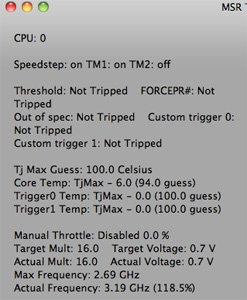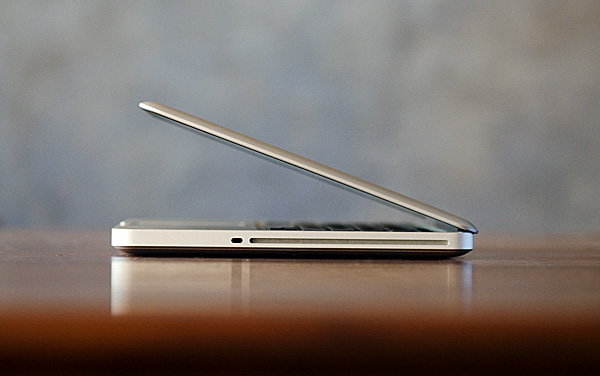The MacBook Pro Review (13 & 15-inch): 2011 Brings Sandy Bridge
by Anand Lal Shimpi, Brian Klug & Vivek Gowri on March 10, 2011 4:17 PM EST- Posted in
- Laptops
- Mac
- Apple
- Intel
- MacBook Pro
- Sandy Bridge
What About The 13?
Apple's new 13-inch MacBook Pro received the biggest upgrade of the lot. Last year Apple opted against moving the 13-inch model to Arrandale and instead gave it a beefy GPU and a mildly evolved Core 2 Duo CPU. The presumed public reasoning was Apple didn't like Arrandale's GPU performance and needed a two chip solution to maintain the platform's size hence the NVIDIA GT 330M + Intel Core 2 Duo setup. Internally I'm wondering if there was a small amount of corporate politics being played there. Apple used to get a discount on Intel CPUs in exchange for exclusivity, that agreement expired with Nehalem. When Nehalem hit, Apple had to pay the same price as everyone else for CPUs. Now does the 2010 Core 2 based 13-inch MacBook Pro make more sense? Keeping Intel's flagship CPU out of Apple's highest volume MacBook Pro had to hurt. I wonder if Apple got discounted pricing on Sandy Bridge as a result...
| Evolution of the 13-inch MacBook Pro | Early 2011 | Mid 2010 | Late 2009 |
| CPU | Intel Core i5 2.3GHz (DC) | Intel Core 2 Duo 2.40GHz (DC) | Intel Core 2 Duo 2.26GHz (DC) |
| Memory | 4GB DDR3-1333 | 4GB DDR3-1066 | 2GB DDR3-1066 |
| HDD | 320GB 5400RPM | 250GB 5400RPM | 160GB 5400RPM |
| Video | Intel HD 3000 (integrated) | NVIDIA GeForce 320M (integrated) | NVIDIA GeForce 9400M (integrated) |
| Optical Drive | 8X Slot Load DL DVD +/-R | 8X Slot Load DL DVD +/-R | 8X Slot Load DL DVD +/-R |
| Screen Resolution | 1280 x 800 | 1280 x 800 | 1280 x 800 |
| USB | 2 | 2 | 2 |
| SD Card Reader | Yes | Yes | Yes |
| FireWire 800 | 1 | 1 | 1 |
| ExpressCard/34 | No | No | No |
| Battery | 63.5Wh | 63.5Wh | 60Wh |
| Dimensions (W x D x H) | 12.78" x 8.94" x 0.95" | 12.78" x 8.94" x 0.95" | 12.78" x 8.94" x 0.95" |
| Weight | 4.5 lbs | 4.5 lbs | 4.5 lbs |
| Price | $1199 | $1199 | $1199 |
While the 15-inch MacBook Pro is quad-core only, the new 13 is strictly dual-core. You get two options: a 2.3GHz or 2.7GHz dual-core Core i5 or Core i7. In Intel speak it's the Core i5-2410M or the Core i7-2620M (it's no wonder Apple doesn't list model numbers for these things).

The 2011 13-inch MacBook Pro Motherboard
| Apple 13-inch 2011 MacBook Pro CPU Comparison | ||||
| 2.3GHz dual-core | 2.7GHz dual-core | |||
| Intel Model | Core i5-2410M | Core i7-2620M | ||
| Base Clock Speed | 2.3GHz | 2.7GHz | ||
| Max SC Turbo | 2.9GHz | 3.4GHz | ||
| Max DC Turbo | 2.6GHz | 3.2GHz | ||
| GPU Base Clock Speed | 650MHz | 650MHz | ||
| GPU Max Turbo | 1.2GHz | 1.3GHz | ||
| L3 Cache | 3MB | 4MB | ||
| AES-NI | No | Yes | ||
| VT-x | Yes | Yes | ||
| VT-d | No | Yes | ||
| TDP | 35W | 35W | ||
The primary differences between these two parts are clock speed, L3 cache size and AES-NI support once again. The 2.3GHz Core i5 lacks AES-NI, has a 3MB L3 cache and can only turbo up to 2.9GHz. The 2.7GHz Core i5 has AES-NI, a 4MB L3 cache and can turbo up as high as 3.4GHz.

I verified turbo frequencies on the 2.7GHz 13-inch. The highest I saw single core turbo hit was 3.4GHz, and dual core turbo was good for 3.2GHz. There's absolutely no funny business going on here, the dual-core 2.7 is allowed to hit its maximum frequencies.

You'll notice that the 2.7GHz DC chip has the same max single core turbo as the 2.3GHz QC chip from the upgraded 15-inch MacBook Pro. In practice this means that for light workloads the upgraded 15 won't feel any faster than the 13 (or that the 13 will feel as fast as the 15 depending on how you look at it). I'm talking about things like web page load times and application launch/install times. There may even be a slight performance advantage for the 13-inch setup as it's able to turbo up to higher frequencies easier than the quad-core 15. Crank up the threads and you've got a different story entirely of course. There's no replacement for more cores on highly threaded workloads.











198 Comments
View All Comments
Anand Lal Shimpi - Friday, March 11, 2011 - link
Thank you for reading them, comments like this really do make it all worthwhile :)You wouldn't believe how much time was spent making sure Apple wasn't doing something funny with the max turbo frequencies. At the end of the day it was a non-issue, but we had to be sure.
Take care,
Anand
Ryan Smith - Friday, March 11, 2011 - link
Just to add some technical background to this, it's actually quite complex to get a CPU speed reading on modern CPUs. Mac OS X's Sysctl reports the base speed of the processor, regardless whether Turbo Mode is active or not. So on the 15" low-end QC model you will always see 2.3GHz.To actually read the instantaneous speed of any given core, you need to peek at the CPU itself and count the cycles - Intel actually has a handy document detailing an algorithm to do this(1). The issue with that is that it requires peeking at the Model-Specific Registers (MSRs), which require Ring 0 access; or in other words you need a broker at the driver level to do it.
Linux already does this (/proc/cpu/0/msr), and on Windows it's fairly trivial to load a driver alongside an Admin-level application to do this(CPU-Z, etc). Under Mac OS X this requires installing an Extension (at least as far as I know) which gets messy. If you don't go through this process you'll never be able to read the core speeds accurately, which is why there's virtually no Mac software capable of this.
Fortunately MSR Tools exists, and it has a 32bit extension to allow it to peek at the MSRs. The right answer of course is always the last answer you try, so this was only after trying several other ways of calculating the CPU speed and a couple different OS-agnostic benchmarks to try to rule out OS differences.
1) http://download.intel.com/design/processor/applnot...
tno - Friday, March 11, 2011 - link
+1I've been planning to plunge into Mac ownership for sometime, especially with grad school looming I really want something that's more comfortable to work on than my netbook but still fairly portable. This review really helped me gauge whether it was worth putting in the extra cost for a 2011 13" MBP or settle for a discounted 2010.
So am I all set? Hardly! Now I need to see what the 2011 13" MBA has to offer! I'm praying that cost stays roughly the same and a move to a ULV SNB leads to 12+ hour battery life and a similarly huge leap in performance as the move lead to in the MBP. I am a sucker for lightweight form factors.
This article is also the first one to make me ever consider the 15" MBP. I have been fairly opposed to the bulk but the performance is quite something. If I went that route then I would probably have a C2Q, water-cooled, ATI and SSD driven rig to put up on AT forums. Taking offers!
tno - Wednesday, May 4, 2011 - link
Rezzing a dead thread! I bought the 13" MBP! $999 at MicroCenter, too good to pass up! So . . . who wants my rig?JasperJanssen - Saturday, August 6, 2011 - link
I, on the other hand, have gone the other way. My MBA13 is being put together in China now.ltcommanderdata - Thursday, March 10, 2011 - link
A great review. I do have some additional questions though. First, given Apple was the instigator of OpenCL, it'd be great if you could run some OpenCL benchmarks. Are the Sandy Bridge MacBook Pro's disproportionately faster than the Arrandale MacBook Pro to indicate that OS X has CPU OpenCL drivers that can take advantage of AVX? Probably not, and this will hopefully come with Lion. Given nVidia's GPGPU push can the HD 6490 still keep up with the 330M GT in OpenCL? How does the HD6750 do?http://www.bit-tech.net/hardware/graphics/2011/01/...
"'[Intel] will be releasing OpenCL graphics drivers to developers during the course of 2011. [Intel] continue to evaluate when and where OpenCL will intercept various products"
And is there secret Sandy Bridge IGP OpenCL support? Bit-tech got a quote from Intel that Sandy Bridge IGP OpenCL support was inbound sometime this year and if anyone would be motivated to get it done it'd be Apple.
And finally, does Apple now support hardware H.264 decoding on ATI or Intel GPUs? Previously, only a few nVidia GPUs were supported in Snow Leopard, such that the Arrandale MacBook Pro actually had to power up the 330M GT to decode H.264 wasting power compared to the perfectly fine Arrandale IGP if Apple just wrote the drivers. Do the new Sandy Bridge have the ATI GPUs doing H.264 decoding now, is the Intel IGP supported, or in the worst case is no H.264 hardware acceleration available now that nVidia GPUs are gone? Perhaps lack of hardware H.264 decoding is what makes the FaceTime HD CPU usage so high? QuickSync is only accelerating the encoding phase?
Anand Lal Shimpi - Friday, March 11, 2011 - link
Some answers:1a) I don't know of any good GPU based OpenCL tests under OS X at this point. I'm not even sure if Apple's Intel HD 3000 driver supports OpenCL.
1b) Intel mentioned SNB's GPU technically supports OpenCL however there are no plans to release a public driver at this point.
2) Hardware H.264 decoding is enabled on the 2011s and it is used while FaceTiming, at least according to Apple.
Take care,
Anand
ltcommanderdata - Friday, March 11, 2011 - link
Thanks for the reply.http://www.macupdate.com/app/mac/33632/smallluxgpu
In regards to OpenCL testing, most people in OS X seem to use SmallLuxGPU which is an OpenCL raytracing benchmark. I don't have much experience with it, but it might be worth a try.
In regards to hardware H.264 decode, do you know if the IGP is doing it or does the discrete GPU still have to be powered up as in the 2010 Arrandale MacBook Pros?
Thanks
Anand Lal Shimpi - Friday, March 11, 2011 - link
It's my understanding that the IGP can do the decoding, although note that while FaceTime is running the dGPU is enabled by default.Good call on SLG, I had forgotten about that :)
Take care,
Anand
secretmanofagent - Thursday, March 10, 2011 - link
Hello authors,On one of the pages, you mentioned this:
"This isn't Mac specific advice, but if you've got a modern Mac notebook I'd highly recommend upgrading to an SSD before you even consider the new MacBook Pro. I've said this countless times in the past but an SSD is the single best upgrade you can do to your computer."
Is there an article where you recommend the best update for my model? Should I even bother with the drive? I realize the X3100 is going to still hamper any sort of graphical performance, but wondering if it's worth the effort.
Out of curiosity as well, would a Time Machine restore be possible if you update the drive?